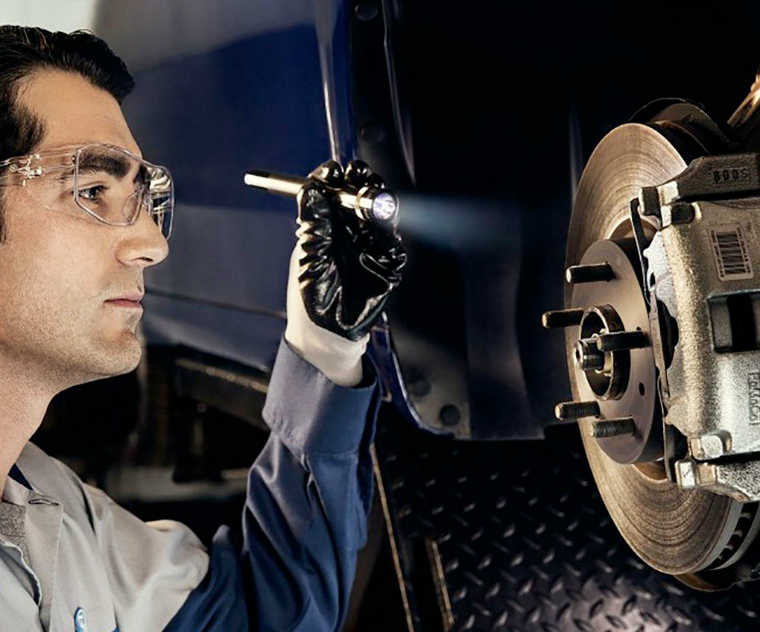Since the invention of the Model T back in 1908, Ford has been recognised for producing vehicles perfect for everyday driving. Nothing fancy nor out of the ordinary, reliable and familiar models that everyone can afford. The reliability these vehicles provide is thanks to Henry Ford’s habit of adopting new technologies, one of which was the brake pad.
The revolutionary braking system that made use of a brake pad was first seen in 1902. Disc brakes are what these braking systems are called and they make for far more efficient braking and a brake that has a longer lifespan. While disc brakes are mostly equipped on the front two wheels when it comes to newer Ford models there are some that go on the rear as well.

Are Front and Rear Brake Pads the Same?
While for the most part front and rear brake pads have the same role, the braking systems in place aren’t. A pad is a pad, but it is only used in disc brakes. We know that disc brakes mainly go on the front wheels, but there are also Ford rear brake pads. You will find that most Ford rear brake systems are based on drums rather than pads. Since there are different types of brakes on the same model, this means they don’t usually wear out the same. way
How Often do You Need to Replace Rear Brake Pads?
Generally speaking, brake pads need to be replaced after you’ve driven about 80,000 km. This depends on your driving habits though, and it can also be after 110,000 km if you’ve been mainly driving your vehicle on smooth terrain. Anywhere between 80,000 km and 110,000 km is the norm for most brake pads.
Should You Replace All 4 Brake Pads at Once?
If your vehicle has both front and Ford rear brake pads, then what you should do is replace them in pairs once you notice any signs of deterioration. You can also replace them all at once if the situation requires you to do so. But this can be avoided if you take good care of your Ford brake pads and braking systems no matter what type they are.

Replacement of Rear Brake Pads Explained
When replacing the rear or front brake pads, you need to first remove the wheels. This part is done by placing wheel chocks in the front of the wheels. With a jack in place, your vehicle is lifted enough for it to put some pressure on the jack. A lug or an impact wrench is used to loosen the lug nuts on the wheel and the vehicle is lifted until the wheels come off the ground. The wheels are then removed.
After that, the bolts from the calliper pins are removed too with a box-end wrench. The calliper is hung up and away from the working area with some bungee cord or mechanics wire to avoid it putting any tension on the brake line. Afterwards, the bolts holding the calliper bracket in place are removed. This is where mechanics use a longer wrench since it offers more torque.
Next, the calliper guide pins get lubricated with a good calliper grease. The pins are replaced and then twisted in to distribute the lubricant evenly. Once that is done the brake pads are taken out of the calliper bracket by pulling the stainless steel retainer clips from the grooves. The dust generated by the pads is brushed off with a wire brush.
The calliper bracket is reattached by twisting the two anchor bolts. Then, the new brake pads are seated in place. This is done by placing the pads in with the metal flange attached on the inside of your Ford brake pad. The friction material is placed facing the rotor. Lastly, the calliper itself is reattached over the new brake pads and the wheel is put back in place.

Caring for Your Rear Brake Pads
Check
Whilst you may not experience any issues or difficulties when braking, its important to check the pads and rotors from time to time to avoid major issues. These two components deteriorate faster than any other and thus require more frequent maintenance.
Flush
To flush the brakes it means to flush the brake fluid. This is done when you start noticing issues with the pressure in the master cylinder. This results in a spongy brake pedal. Flushing brake fluid should be done by a professional and usually around every 40,000 km.
Bleed
This process also involves the brake fluid and doing it keeps the brake lines working well too. Bleeding the brake lines is done when there is air in them. Air can get trapped and reduce the efficiency of the braking system. Bleeding should also be done by a certified mechanic and it usually takes place every 2 or 3 years. Although all this is required to prolong the lifespan of a braking system, replacing the pads is still inevitable.














